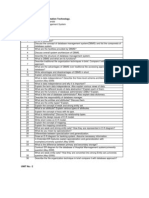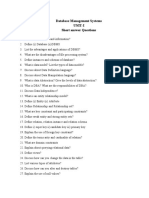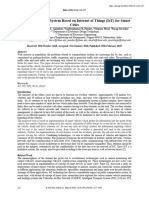0% found this document useful (0 votes)
25 views2 pagesQuestion Bank DBMS
The document is a question bank for a Database Management Systems (DBMS) course, organized into five units covering fundamental concepts such as database definitions, DBMS architecture, data models, normalization, transactions, and NoSQL databases. Each unit contains multiple questions that require detailed explanations and examples, focusing on both theoretical and practical aspects of DBMS. Topics include advantages of DBMS, relational operations, SQL functions, normalization principles, transaction properties, and comparisons between SQL and NoSQL databases.
Uploaded by
Jayshree BorkarCopyright
© © All Rights Reserved
We take content rights seriously. If you suspect this is your content, claim it here.
Available Formats
Download as DOCX, PDF, TXT or read online on Scribd
0% found this document useful (0 votes)
25 views2 pagesQuestion Bank DBMS
The document is a question bank for a Database Management Systems (DBMS) course, organized into five units covering fundamental concepts such as database definitions, DBMS architecture, data models, normalization, transactions, and NoSQL databases. Each unit contains multiple questions that require detailed explanations and examples, focusing on both theoretical and practical aspects of DBMS. Topics include advantages of DBMS, relational operations, SQL functions, normalization principles, transaction properties, and comparisons between SQL and NoSQL databases.
Uploaded by
Jayshree BorkarCopyright
© © All Rights Reserved
We take content rights seriously. If you suspect this is your content, claim it here.
Available Formats
Download as DOCX, PDF, TXT or read online on Scribd
/ 2































































